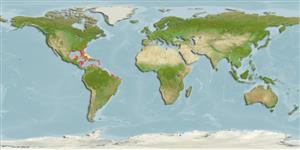Demospongiae |
Tetractinellida |
Tetillidae
Environment: milieu / climate zone / djupintervall / distribution range
Ekologi
; djupintervall 17 - 50 m (Ref. 108813). Tropical
Western Atlantic.
Length at first maturity / Size / Weight / Age
Könsmognad: Lm ? range ? - ? cm
Globular or subglobular, grows up to 4.5 cm across. Specimens between .05 to 1.5 cm are ovoid erect, rarely stalked. Surface covered with 2 to 6 large elevated cup-like depressions (i.e., porocalices) at widths between .05 to 1 cm. Spicules present, radiated with protruding tips covering the remaining surface. Color ranges from orange to yellow, reddish brown, or gray; paler internally. Firm consistency, small specimens softer. Oscules on top of cone-shaped protuberances, smaller than porocalices. Spongin fibers absent (Ref. 85482).
Occurs in deeper rock pavements and hard bottoms (Ref. 85482).
Life cycle and mating behavior
Könsmognad | Reproduktion | Lek | Eggs | Fecundity | Larvae
Members of the class Demospongiae are hermaphroditic. Life cycle: The zygote develops into parenchymella larva (free-swimming) before settling down on a substrate where it grows into a young sponge.
Messing, C.. 2010 Interactive sponge guide of Florida. Available online at http://www.nova.edu/ncri/sofla_sponge_guide/index.html. Accessed 9 November 2010. (Ref. 85482)
IUCN Red List Status
(Ref. 130435: Version 2025-1)
CITES status (Ref. 108899)
Not Evaluated
Not Evaluated
Threat to humans
Harmless
Human uses
| FishSource |
Verktyg
Ytterligare information
Trophic EcologyFood items (preys)
Födosammansättning
Födointag
Predatorer
Population dynamicsTillväxt
Max. ages / sizes
Length-weight rel.
Length-length rel.
Length-frequencies
Mass conversion
Abundans
PhysiologySyreförbrukning
Human RelatedStamps, coins, misc.
Internet-källor
Estimates based on models
Preferred temperature
(Ref.
115969): 22.9 - 27.8, mean 24.8 (based on 78 cells).
